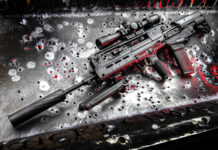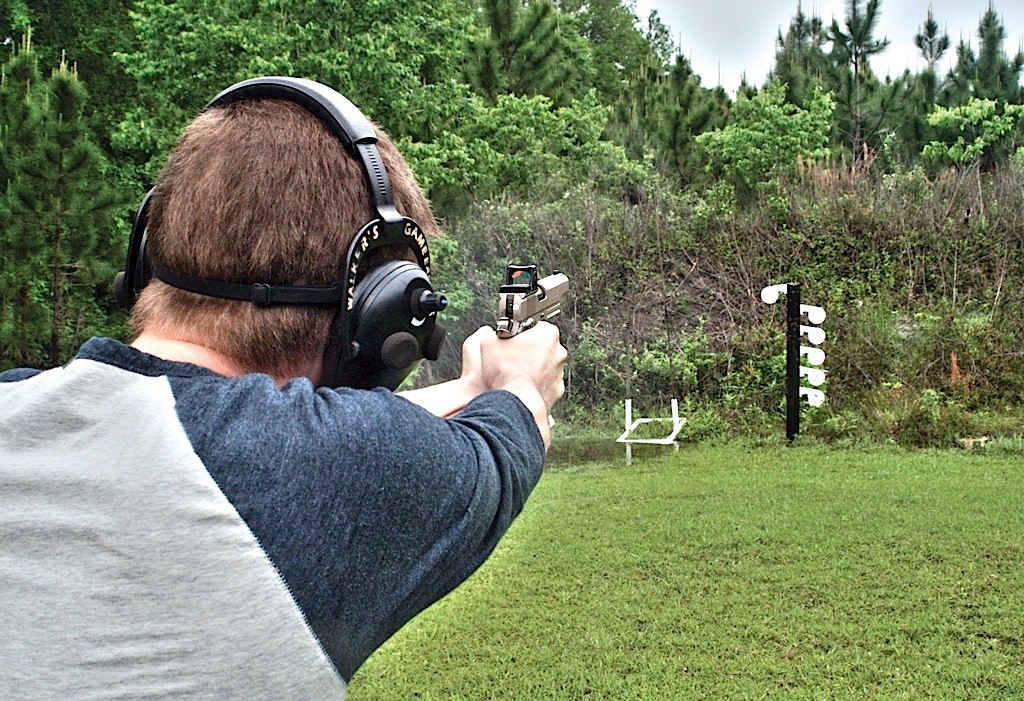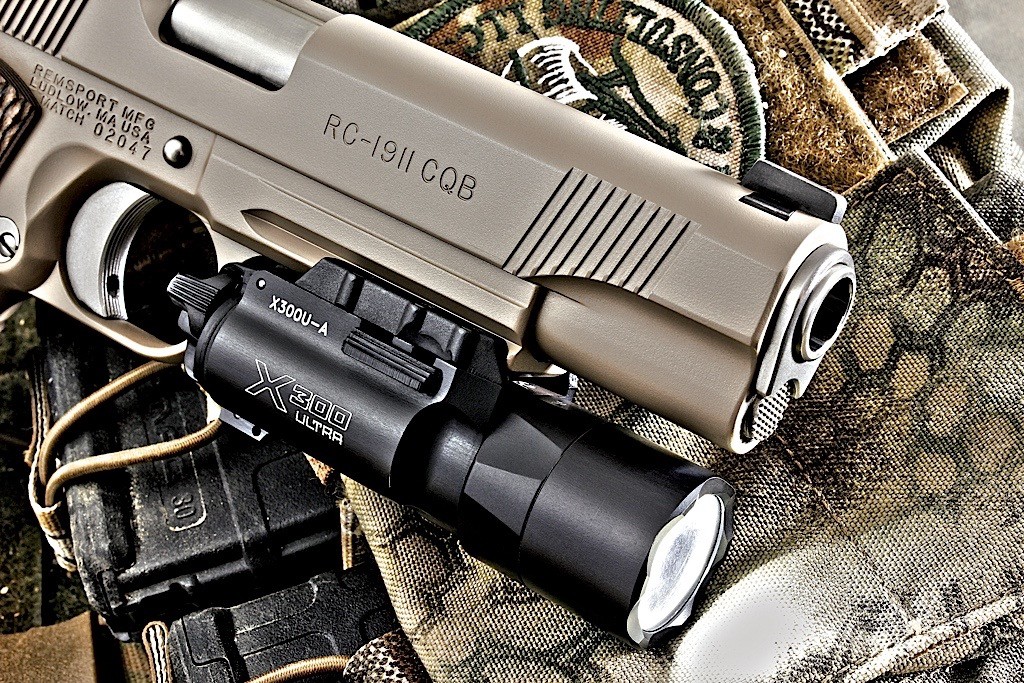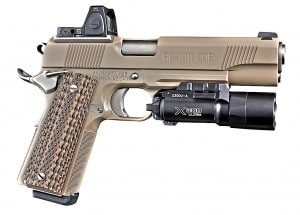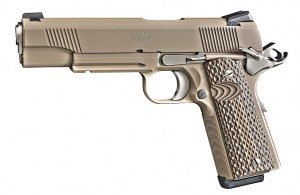Handling
The Robar’s slide worked so smoothly along the frame that one of our testers kept racking the slide just to feel it. This was true with both slides—the iron-sighted slide and the one with the RMR optic installed—running on the same frame. Both slides had conventional vertical serrations front and rear.
Instead of the frequently seen full-length guide rod, this pistol comes with the short recoil spring guide rode originally designed by John Moses Browning, which makes the pistol easier to field strip and reassemble.
Using a Lyman digital gauge, we found that the trigger pull averaged 4.14 pounds. The break was clean with no perceptible backlash. Our gun arrived sporting a Greider/Videcki trigger with narrow serrated face, short enough that I could get my index finger on it at the distal joint. This finger placement, I’ve found, gives the shooter more leverage for fast, controlled shooting.
Our gun differed from standard Robar specification in one respect: while this model normally ships from Robar with an Ed Brown extended magazine release, our sample was fitted with one designed for concealed carry by Hilton Yam at 10-8. It slants forward and down in a wedge shape, presumably to prevent accidental release when worn tight to the body. It looked weird at first, but it turned out that no one on the test team had a problem with it, and most were surprised at how well it worked. John Strayer, a 5-gun IDPA Master and several-time state and regional champion, has been focusing on shooting 1911 .45s lately, and had just returned from the 2014 Single Stack Championships in Illinois. He said, “That damn mag catch looked funky at first, but the more I worked with it, the more I liked it. I think it’s great for a carry gun.”
Accuracy
I was curious to compare the iron-sighted slide’s accuracy with its RMR-sighted counterpart, and tried both from the bench with 185-grain jacketed hollow point, 230-grain JHP and generic 230-grain FMJ “hardball.” Each 5-shot group was measured overall, and again for the best three shots. This factors out human error to a sufficient degree to roughly duplicate what the same gun and ammo will do for all five shots from a machine rest, and it’s also an easier test for most readers to duplicate.
The 185-grain JHP was Federal’s venerable 45C load, which has proven so accurate over the years that Federal used to brand it as “Match” hollow point. With the Novak-sighted slide it planted five .45-caliber holes in a group measuring just under an inch high by 2.50” wide. The best three were less than half that far apart, at 1.15”, all measurements being taken center to center to the nearest 0.05”. Using the RMR-sighted slide on the same frame, the Federal 185-grain did 2.55” for all five, with four in 1.15” (the same dimensions as the best three with iron sights). The best 3-shot cluster of the entire test was done with the Federal under the Trijicon RMR: seven-tenths of an inch, center to center.
For a 230-grain JHP we used the relatively new Nosler Match, which has already earned a reputation for splendid accuracy in many other .45s. This time, we had one stray shot—that may well have been my error—stretch the 5-shot group out to 4.30” with iron sights, but the other four shots were in 2.35” and the best three in 1.40”. Running under the Trijicon optic, the Robar pistol put a quintet of .45 holes into 2.60” and the best three in 1.60”.
The classic training/practice load in .45 ACP is 230-grain FMJ, and Winchester USA brand “white box” may be the most popular of its kind. With the big Novak night sights it delivered a 5-shot group of 2.80”, with four shots in 1.60” and the best three in 1.05”, the second best cluster of the test. With the RMR optic, the 5-shot group with Winchester hardball measured 3.65”, with four of those shots in 2.35” and the best three in 1.70”.
Carrying With RMR Mounted
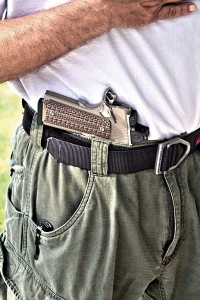 The only holster we could find cut deeply enough in front to take the RMR
The only holster we could find cut deeply enough in front to take the RMR 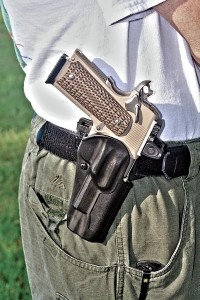 optic, and also take a light-railed frame, was an inexpensive Blackhawk plastic scabbard that actually worked fine. The optic, however, does create a hump-back effect on the top of the slide, which in turn creates a bulge point when worn at the hip. This is probably why so many people who carry RMR-sighted guns daily wind up holstering them at the appendix position, where that bulging area is more flat against the abdomen.
optic, and also take a light-railed frame, was an inexpensive Blackhawk plastic scabbard that actually worked fine. The optic, however, does create a hump-back effect on the top of the slide, which in turn creates a bulge point when worn at the hip. This is probably why so many people who carry RMR-sighted guns daily wind up holstering them at the appendix position, where that bulging area is more flat against the abdomen.
Reliability
Here, we had a problem right off the bat. The trigger frequently failed to return. I hand delivered the gun to editor Ben Battles at the NRA annual meeting. He tried it, found the same and sent it back to Robar. They quickly got it back to us, with apologies.
Robar’s Freddie Blish explained, “We found that the metal prep of the trigger bow was not adequate. We went through a few new guys in our metal prep shop before finding the one we have now. The trigger was prepped during that time frame. What happened is the NP3 on the bow was flaking and caused it to drag.”
They fixed it, ran 150 rounds through it with no problems, and sent it back. We didn’t have any problems with it after that, either. Before and since its trip back to Robar, the gun had fed, ejected and otherwise cycled perfectly with everything we fed it. Between On Target’s deadline and the gun’s perambulations—from Phoenix, to the magazine’s offices in New Hampshire, to me in Florida, to the NRA Show, then to New Hampshire, Arizona and Florida again—well, we just didn’t have time to put as many rounds through it as we usually do. We did get several hundred assorted .45 ACPs downrange from it, though, and once the trigger bow problem was squared away, the gun ran 100% with both slides.
Iron Sights or Optics?
A lot of it comes down to habituation. We found ourselves a little slower finding the red dot when coming up fast from low ready or out of the Blackhawk holster, and the higher sight axis over bore axis does seem to require the shooter to learn a new wrist angle with the same gun. For the most part, the folks I know who are actually carrying red dot optics on their personal defense handguns went to them because eye problems often associated with aging had been impairing their ability to clearly see more conventional sights. That’s reason enough for the switch, and the fact that they stayed with the optics tells me that the concept is a “fix” that works. And that’s certainly worth some extra money for the hardware, and some re-habituation time on the range.
Of course, you don’t need to be a geezer like me to appreciate this technology. The youngest member of our test team is Owen Davis, age 21. After racing the dueling tree with the RMR-equipped Robar from 45 feet away, and gaining six hits for six shots, he exclaimed, “You can’t miss with this!”
If you don’t need the optics now, you might in the future, and it’s good to know the option is there. It’s also good to know that we have one more high-end 1911 available from a reputable industry source. For more information, contact The Robar Companies, Dept. OT.; Tel.: (623) 581-2648; Web: www.robarguns.com










